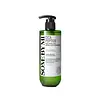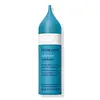What's inside
What's inside
 Key Ingredients
Key Ingredients

 Benefits
Benefits

 Concerns
Concerns

 Ingredients Side-by-side
Ingredients Side-by-side

Water
Skin ConditioningCocamidopropyl Betaine
CleansingTea-Cocoyl Glutamate
CleansingSodium Lauroyl Methylaminopropionate
CleansingDisodium Laureth Sulfosuccinate
CleansingCocamide Mea
EmulsifyingSodium Chloride
MaskingParfum
MaskingPolyquaternium-10
Caprylyl Glycol
EmollientHydroxyacetophenone
AntioxidantPPG-3 Myristyl Ether
EmollientPanthenol
Skin ConditioningSalicylic Acid
MaskingMenthol
MaskingCitric Acid
BufferingNiacinamide
SmoothingSodium Benzoate
MaskingPentasodium Pentetate
Butylene Glycol
HumectantGluconolactone
Skin ConditioningAminomethyl Propanol
Buffering1,2-Hexanediol
Skin ConditioningBiotin
AntiseborrhoeicMentha Piperita Leaf Extract
Skin ConditioningMentha Viridis Extract
MaskingLeonurus Sibiricus Flower/Leaf/Stem Extract
SoothingNelumbo Nucifera Flower Extract
Skin ConditioningHouttuynia Cordata Extract
Skin ConditioningArtemisia Vulgaris Extract
Skin ConditioningCamellia Sinensis Leaf Extract
AntimicrobialMentha Rotundifolia Leaf Extract
TonicCentella Asiatica Extract
CleansingEthylhexylglycerin
Skin ConditioningHydrolyzed Corn Protein
Skin ConditioningHydrolyzed Soy Protein
HumectantHydrolyzed Wheat Protein
Skin ConditioningHexapeptide-9
Skin ConditioningPalmitoyl Pentapeptide-4
Skin ConditioningPalmitoyl Tripeptide-5
Skin ConditioningPalmitoyl Tripeptide-1
Skin ConditioningPalmitoyl Tetrapeptide-7
Skin ConditioningPalmitoyl Oligopeptide
CleansingTripeptide-1
Skin ConditioningCopper Tripeptide-1
Skin ConditioningAsiatic Acid
Skin ConditioningAsiaticoside
AntioxidantAcetyl Hexapeptide-8
HumectantAcetyl Tetrapeptide-2
Skin ConditioningMadecassic Acid
Skin ConditioningMadecassoside
AntioxidantNonapeptide-1
Skin ConditioningWater, Cocamidopropyl Betaine, Tea-Cocoyl Glutamate, Sodium Lauroyl Methylaminopropionate, Disodium Laureth Sulfosuccinate, Cocamide Mea, Sodium Chloride, Parfum, Polyquaternium-10, Caprylyl Glycol, Hydroxyacetophenone, PPG-3 Myristyl Ether, Panthenol, Salicylic Acid, Menthol, Citric Acid, Niacinamide, Sodium Benzoate, Pentasodium Pentetate, Butylene Glycol, Gluconolactone, Aminomethyl Propanol, 1,2-Hexanediol, Biotin, Mentha Piperita Leaf Extract, Mentha Viridis Extract, Leonurus Sibiricus Flower/Leaf/Stem Extract, Nelumbo Nucifera Flower Extract, Houttuynia Cordata Extract, Artemisia Vulgaris Extract, Camellia Sinensis Leaf Extract, Mentha Rotundifolia Leaf Extract, Centella Asiatica Extract, Ethylhexylglycerin, Hydrolyzed Corn Protein, Hydrolyzed Soy Protein, Hydrolyzed Wheat Protein, Hexapeptide-9, Palmitoyl Pentapeptide-4, Palmitoyl Tripeptide-5, Palmitoyl Tripeptide-1, Palmitoyl Tetrapeptide-7, Palmitoyl Oligopeptide, Tripeptide-1, Copper Tripeptide-1, Asiatic Acid, Asiaticoside, Acetyl Hexapeptide-8, Acetyl Tetrapeptide-2, Madecassic Acid, Madecassoside, Nonapeptide-1
Water
Skin ConditioningPropanediol
SolventMandelic Acid
AntimicrobialGlycolic Acid
BufferingGluconolactone
Skin ConditioningIsopentyldiol
HumectantPPG-24-Glycereth-24
EmulsifyingSaccharide Isomerate
HumectantMethyl Diisopropyl Propionamide
MaskingGaultheria Procumbens Leaf Extract
PerfumingAgave Tequilana Leaf Extract
AstringentBeta Vulgaris Root Extract
Skin ConditioningPentylene Glycol
Skin ConditioningPPG-26-Buteth-26
Skin ConditioningBetaine
HumectantGluconic Acid
Lysolecithin
EmulsifyingSclerotium Gum
Emulsion StabilisingCitric Acid
BufferingPullulan
Cellulose Gum
Emulsion StabilisingXanthan Gum
EmulsifyingHydroxyacetophenone
AntioxidantPEG-40 Hydrogenated Castor Oil
EmulsifyingSodium Citrate
BufferingSodium Benzoate
MaskingSodium Hydroxide
BufferingParfum
MaskingLimonene
PerfumingWater, Propanediol, Mandelic Acid, Glycolic Acid, Gluconolactone, Isopentyldiol, PPG-24-Glycereth-24, Saccharide Isomerate, Methyl Diisopropyl Propionamide, Gaultheria Procumbens Leaf Extract, Agave Tequilana Leaf Extract, Beta Vulgaris Root Extract, Pentylene Glycol, PPG-26-Buteth-26, Betaine, Gluconic Acid, Lysolecithin, Sclerotium Gum, Citric Acid, Pullulan, Cellulose Gum, Xanthan Gum, Hydroxyacetophenone, PEG-40 Hydrogenated Castor Oil, Sodium Citrate, Sodium Benzoate, Sodium Hydroxide, Parfum, Limonene
 Reviews
Reviews

Alternatives
Ingredients Explained
These ingredients are found in both products.
Ingredients higher up in an ingredient list are typically present in a larger amount.
Citric Acid is an alpha hydroxy acid (AHA) naturally found in citrus fruits like oranges, lemons, and limes.
Like other AHAs, citric acid can exfoliate skin by breaking down the bonds that hold dead skin cells together. This helps reveal smoother and brighter skin underneath.
However, this exfoliating effect only happens at high concentrations (20%) which can be hard to find in cosmetic products.
Due to this, citric acid is usually included in small amounts as a pH adjuster. This helps keep products slightly more acidic and compatible with skin's natural pH.
In skincare formulas, citric acid can:
While it can provide some skin benefits, research shows lactic acid and glycolic acid are generally more effective and less irritating exfoliants.
Most citric acid used in skincare today is made by fermenting sugars (usually from molasses). This synthetic version is identical to the natural citrus form but easier to stabilize and use in formulations.
Read more about some other popular AHA's here:
Learn more about Citric AcidGluconolactone is a PHA. PHAs are a great gentle alternative to traditional AHAs.
When applied, Gluconolactone has the same affect on skin as AHAs such as lactic acid. It helps dissolve the dead skin cells in the top layer of your skin. This improves texture and brightens the skin.
PHAs are more gentle than AHAs due to their larger structure. They do not penetrate as deeply as AHAs and take a longer time to dissolve dead cells. Studies show PHAs do not cause as much irritation.
Gluconolactone has some interesting properties:
In a 2004 study, Gluconolactone was found to prevent UV damage in mouse skin cells and has not been found to increase sun sensitivity. However, we still recommend wearing SPF daily.
This ingredient is is an created by reacting gluconic acid with an alcohol.
Learn more about GluconolactoneHydroxyacetophenone is antioxidant with skin conditioning and soothing properties. It also boosts the efficiency of preservatives.
This ingredient is not irritating or sensitizing.
Parfum is a catch-all term for an ingredient or more that is used to give a scent to products.
Also called "fragrance", this ingredient can be a blend of hundreds of chemicals or plant oils. This means every product with "fragrance" or "parfum" in the ingredients list is a different mixture.
For instance, Habanolide is a proprietary trade name for a specific aroma chemical. When used as a fragrance ingredient in cosmetics, most aroma chemicals fall under the broad labeling category of “FRAGRANCE” or “PARFUM” according to EU and US regulations.
The term 'parfum' or 'fragrance' is not regulated in many countries. In many cases, it is up to the brand to define this term.
For instance, many brands choose to label themselves as "fragrance-free" because they are not using synthetic fragrances. However, their products may still contain ingredients such as essential oils that are considered a fragrance by INCI standards.
One example is Calendula flower extract. Calendula is an essential oil that still imparts a scent or 'fragrance'.
Depending on the blend, the ingredients in the mixture can cause allergies and sensitivities on the skin. Some ingredients that are known EU allergens include linalool and citronellol.
Parfum can also be used to mask or cover an unpleasant scent.
The bottom line is: not all fragrances/parfum/ingredients are created equally. If you are worried about fragrances, we recommend taking a closer look at an ingredient. And of course, we always recommend speaking with a professional.
Learn more about ParfumSodium Benzoate is a preservative. It's used in both cosmetic and food products to inhibit the growth of mold and bacteria. It is typically produced synthetically.
Both the US FDA and EU Health Committee have approved the use of sodium benzoate. In the US, levels of 0.1% (of the total product) are allowed.
Sodium benzoate works as a preservative by inhibiting the growth of bacteria inside of cells. It prevents the cell from fermenting a type of sugar using an enzyme called phosphofructokinase.
It is the salt of benzoic acid. Foods containing sodium benzoate include soda, salad dressings, condiments, fruit juices, wines, and snack foods.
Studies for using ascorbic acid and sodium benzoate in cosmetics are lacking, especially in skincare routines with multiple steps.
We always recommend speaking with a professional, such as a dermatologist, if you have any concerns.
Learn more about Sodium BenzoateWater. It's the most common cosmetic ingredient of all. You'll usually see it at the top of ingredient lists, meaning that it makes up the largest part of the product.
So why is it so popular? Water most often acts as a solvent - this means that it helps dissolve other ingredients into the formulation.
You'll also recognize water as that liquid we all need to stay alive. If you see this, drink a glass of water. Stay hydrated!
Learn more about Water